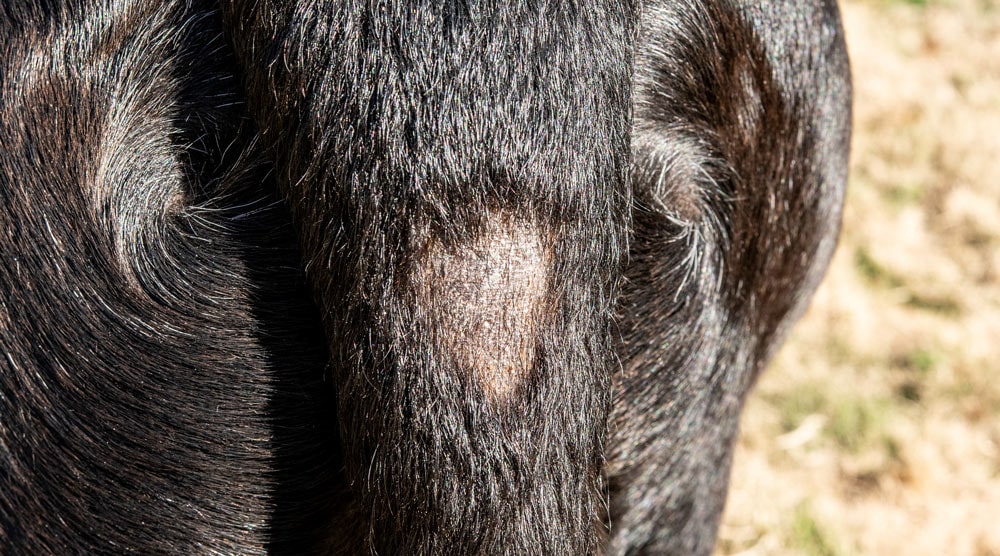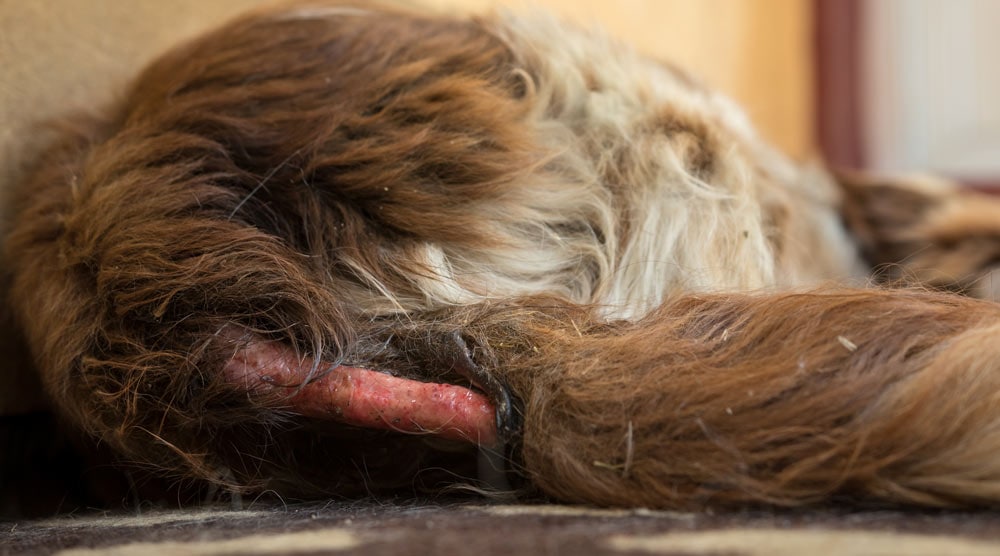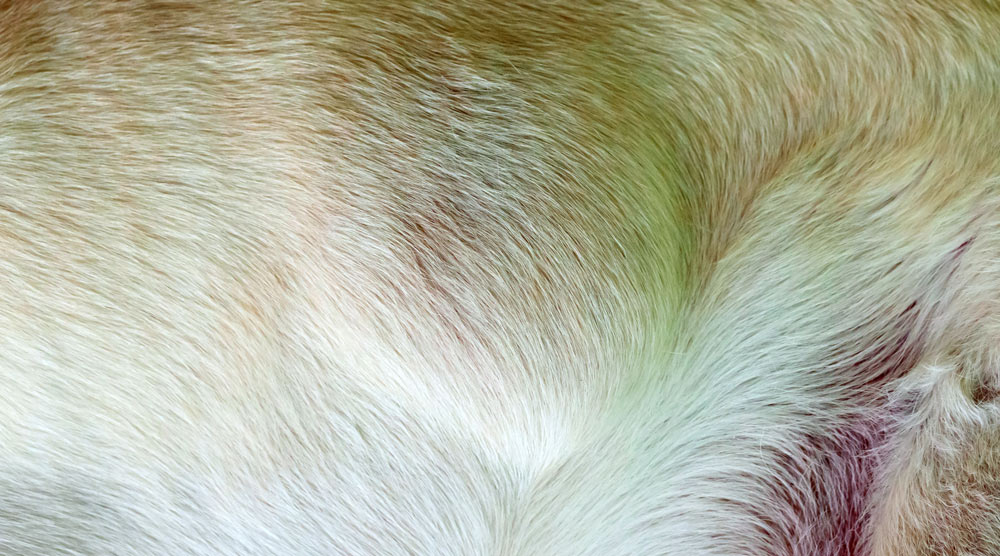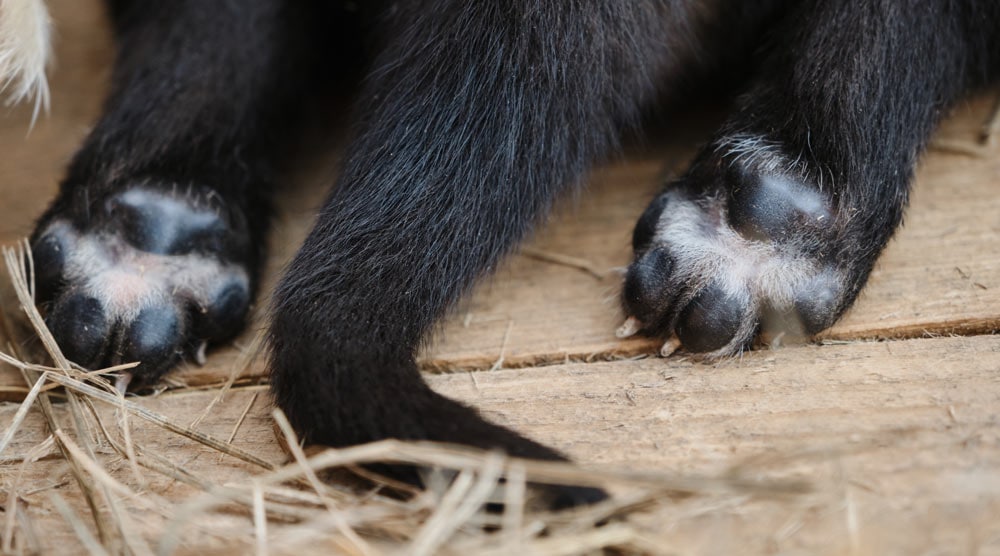It can be very worrying if you notice a new lump on your dog’s tail. You shouldn’t panic though.
While lumps anywhere on a dog’s body should always be checked by a vet, they are often benign or treatable. Even cancerous tail lumps can often be treated if caught early enough.
In this article, we’ll go through the most common causes of a lump in a dog’s tail. We’ll also discuss why getting a vet checkup for any new lump on your dog’s skin is important.
Contents
What Can Cause a Lump in a Dog’s Tail?
Lumps aren’t as common on the tail as other parts of a dog’s body, but they can still develop for a variety of reasons.
Some causes of a lump on the tail are relatively harmless, such as skin tags or matted hair. However, lumps can also be caused by more serious conditions, such as fractured vertebrae or malignant tumors.
For this reason, it’s crucial to schedule a visit to your vet if you notice a new lump on your dog’s tail. Let’s take a closer look at some common reasons for tail lumps.
Stud Tail (Infected Tail Gland)

All dogs have a supracaudal gland on their tails, which secretes proteins and oils. Normally, this gland remains flat and hidden beneath their fur. However, it sometimes becomes infected and swells up, creating a lump on your dog’s tail.
This condition is often called “stud tail.” Aside from a lump, other symptoms of stud tail can include:
- A bald patch on the tail
- Greasy skin and hair around the area
- Hair matting at the tail base
- Your dog might itch or chew the tail
- Redness around the affected area
- An unpleasant odor from the tail
If your veterinarian diagnoses stud tail, they might suggest medicated shampoos or topical treatments to get your pup’s tail back to normal.
Matted Hair
In some cases, what appears to be a lump on your dog’s tail could just be a patch of matted hair. This is more common in dogs with longer fur that’s prone to matting.
It’s often possible to differentiate between a hair lump and a skin lump just by feeling the area. You can also sometimes put your fingers underneath the “lump,” which shows it’s not attached to the skin. However, you should contact a vet if you’re not sure whether a lump is due to matting.
Sebaceous Cysts
Dogs have sebaceous glands all over their skin. These secrete sebum, an oily substance that maintains coat and skin health.
If a sebaceous gland gets blocked, it may become hardened and fill up with a thick fluid. This is called a sebaceous cyst.
Sebaceous cysts present as small lumps on your dog’s skin. They can appear anywhere, including the tail. They’re more prevalent in senior dogs or those with thin hair, such as poodles, but can affect any dog.
In many cases, sebaceous cysts are harmless and may not even require treatment. The exception is if they become infected, which often requires veterinary intervention.
Skin Infections (Folliculitis)

A dog’s hair follicles can get infected, leading to a condition called folliculitis. This is usually caused by a bacterial infection (bacterial folliculitis), although fungal or viral infections can also lead to folliculitis.
Two common triggers for folliculitis are blocked anal glands and fleas. Both can cause the dog to chew and lick the area, especially as the rump and base of the tail are often the itchiest areas for dogs with fleas.
Raised red lumps on the skin are often the most noticeable sign of folliculitis. Other symptoms to watch for include:
- Persistent itching and excessive scratching
- Scabs or crusts surrounding the lumps
- Hair loss in the affected area
- Sensitivity or discomfort when touched
Treatment for folliculitis depends on its root cause. Your vet might prescribe antibiotics for bacterial infections, antifungal treatments for fungal infections, and topical creams to soothe the affected area.
Broken Tail
A fracture can result in a painful kink or bump in your dog’s tail. Unlike many of the other conditions we’ve discussed, this type of lump will appear to be underneath the skin.
Fractures often occur when a tail gets trapped in a door or trodden on. Dogs can also fracture their own tail by wagging hard against a solid surface.
Young puppies can suffer from a broken tail too. “I see this more commonly in very young pups who have had trauma during birth or when their mother has laid on them,” says veterinary surgeon Dr. Linda Simon. “They often don’t seem uncomfortable but we may find a visible ‘kink’ in their tail during their first vet check”.
Aside from a lump or deviation in the tail, you might also notice symptoms like swelling, whining, crying, and difficulty in standing up. In some cases, there could even be an open wound, depending on the severity and nature of the injury.
A tail fracture should always be assessed by a vet. As you can imagine, a broken vertebrae can be immensely painful to your dog, so don’t delay in seeking veterinary help. Treatment depends on the location and severity of the fracture.
Granuloma
Granulomas are solid masses that form on a dog’s skin as a result of bacterial infections. These lumps can form anywhere on the skin, especially the ankles, forearms or toes.
While granulomas can resemble tumors, they are not cancerous. They can usually be treated effectively with antibiotics.
Lick granulomas are quite rare on the tail, so this isn’t the most common cause of a tail lump on this list. However, it’s still worth being aware of them.
Skin Tags
Skin tags are one of the least serious causes of lumps on a dog’s tail. They appear as small flaps or bumps on the skin and can vary in color. While skin tags sometimes need to be removed if they grow too large, most of the time, they are harmless and slow-growing.
Much like sebaceous cysts, skin tags are more common in senior dogs. As always, if you notice any new growth on your dog’s skin, it’s best to consult your vet to rule out other more serious conditions.
Tick

When a tick buries its head into a dog’s skin and fills up with blood, it can form a dark lump. At this stage, it can also be difficult to see the tick’s legs, so it may appear as just a bump in the skin.
It’s crucial to remove a tick from your dog promptly using a tick removal tool, as this reduces the chance of disease transmission (including Lyme disease). Be careful not to leave the tick’s head embedded in your dog’s skin.
If you’re unsure how to remove a tick safely, reach out to your vet for assistance. You might also want to ask them about tick prevention methods, such as tablets or spot-on treatments.
Abscesses
An abscess can form when trauma to the dog’s skin, perhaps from a wound or bite, allows an infection to take hold.
The infection can lead to a lump filled with pus and blood. These abscesses can be very painful for your dog and have a risk of rupturing.
You should always discuss potential abscesses with your vet. Sometimes can be treated with a combination of antibiotics and anti-inflammatories. But larger infected abscesses may need to be lanced and flushed. This allows a drain to be placed to encourage drainage of the infection.
Perianal Adenoma
A perianal adenoma is a benign tumour typically found around the anus, on the underside of a dog’s tail.
This condition is more prevalent in male dogs and is usually easy to diagnose due to its location. Perianal adenomas usually require surgical removal, as they can cause discomfort to your dog.
Treatment may also involve neutering the male. In the case of small non-ulcerated tumours, neutering may be all that’s required, as the lump can sometimes resolve itself without surgery.
Cornifying Epitheliomas
Cornifying epitheliomas are benign growths on a dog’s skin that might resemble a nail or horn. They have a hard texture and can look very unpleasant!
Composed of keratin, these growths can crop up anywhere on a dog’s body, although they are commonly found on the tail and legs. They are most likely to occur in middle-aged dogs, with breeds such as bearded collies and Belgian sheepdogs being more prone.
Cornifying epitheliomas won’t disappear on their own. But if they’re not bothering your dog, your vet may advise leaving them alone.
If your dog starts biting or scratching at the growth, however, then surgical removal might be the best option.
Lipoma

Lipomas are benign tumours in fat cells that reside just beneath the skin. While they are most frequently found on a dog’s abdomen, they can form anywhere on the skin, including the tail.
Lipomas are slow-growing and often don’t need to be removed unless they’re causing discomfort. Larger breeds seem to have a higher likelihood of developing lipomas, but any dog can get them. If your dog is still young, it might be best to remove a lipoma since it could potentially grow very large over time.
Be aware that lipomas can feel similar to more serious conditions, such as soft tissue sarcoma. Because of this, your vet might need to take a sample to differentiate between the two.
Cancerous Tumours
A lump on a dog’s tail can sometimes be caused by a malignant cancerous growth. There are several types of tumours that can affect the skin on the tail. These include:
- Soft tissue sarcoma. This fast-growing tumour affects the connective tissue.
- Mast cell tumour. Another rapidly growing tumour that tends to recur if not completely removed.
- Squamous cell carcinoma. This type of cancer is caused by UV sun damage, making it more common in dogs that enjoy sunbathing.
The key to treating any cancerous tumour is early detection. The prognosis and options for treatment largely depend on the cancer stage and the location of the tumour on the tail. So, if you notice a lump on your dog’s tail, don’t delay seeking veterinary attention.
When Should You Visit a Vet About a Lump on Your Dog’s Tail?
We always recommend visiting a vet whenever you find a new lump on your dog’s tail, or anywhere else on their body. There are many potential causes of a tail lump, so an accurate diagnosis is essential.
While a vet should look at any new lump, the following warning signs are reasons to book a more urgent checkup:
- The lump has grown quickly in size
- The lump is bleeding or oozing pus
- The lump feels hard to touch
- The lump is irregularly shaped
- There are signs of ulceration.
- There’s been a change in the lump’s colour
- Your dog is showing signs of discomfort
Taking a photo is also a smart move. A photographic history can be useful when trying to locate the lump for your vet, and also to track its appearance over time. “I find a good tip when taking photos is to do so alongside a small ruler or coin, so we can assess if the lump has grown,” says vet Linda Simon.
Your vet will perform a physical examination of the lump and the surrounding area. In some cases, a fine needle aspiration (FNA) or biopsy is the only way to accurately determine what’s causing the lump. And, if a fracture is suspected, they may need to get an X-ray.
For serious conditions, such as cancer, early detection often means there are more options for treatment. Waiting only increases the chances that more drastic treatments – such as surgery or tail amputation – may become necessary.
That said, many lumps on a dog’s tail are benign. A vet checkup is essential, but there’s no need to panic if you find a new lump.
What Are Other Common Dog Tail Problems?
Tail lumps aren’t the only issue our four-legged friends might face. Other common dog tail problems include:
- Happy tail syndrome. This is a tough condition to treat, as it involves wounds caused by a dog’s tail wagging against hard surfaces. Treatment usually involves bandages and medications to try and resolve any wounds, while modifying the dog’s environment to allow the tail to heal. In the most severe cases where other treatments have failed, tail amputation might be the only solution to happy tail.
- Limber tail. If your dog’s tail hangs down limply, they could be suffering from limber tail. Believed to be a result of overworked muscles, it’s commonly seen when unfit dogs go on unexpectedly long walks or swims. Limber tail usually resolves in a few days and can be managed with pain relief and anti-inflammatories.
- Allergic skin rashes. Much like humans, dogs can suffer from skin allergies. These can cause skin inflammation, leading to itchiness, rashes, constant licking, and darkened skin.
To catch health issues as early as possible, we recommend a weekly examination of your dog’s body, including the tail. This makes it easier to notice any changes and book a vet checkup if required.
Summary
Discovering a lump on your dog’s tail can be scary, but not all lumps are cancerous. As we’ve seen in this article, tail lumps can be caused by a variety of issues, from infected glands to embedded ticks.
However, you should always take your dog to a vet if you notice a new lump. It’s vital to get an accurate diagnosis and start treatment as quickly as possible, if necessary.
Do you have any questions about lumps on a dog’s tail? Please let us know in the comment section below.




